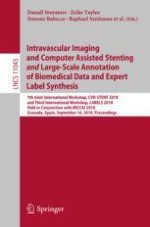
2018 | OriginalPaper | Buchkapitel
Blood-Flow Estimation in the Hepatic Arteries Based on 3D/2D Angiography Registration
verfasst von : Simon Lessard, Rosalie Planteféve, François Michaud, Catherine Huet, Gilles Soulez, Samuel Kadoury
Erschienen in: Intravascular Imaging and Computer Assisted Stenting and Large-Scale Annotation of Biomedical Data and Expert Label Synthesis
Aktivieren Sie unsere intelligente Suche, um passende Fachinhalte oder Patente zu finden.
Wählen Sie Textabschnitte aus um mit Künstlicher Intelligenz passenden Patente zu finden. powered by
Markieren Sie Textabschnitte, um KI-gestützt weitere passende Inhalte zu finden. powered by